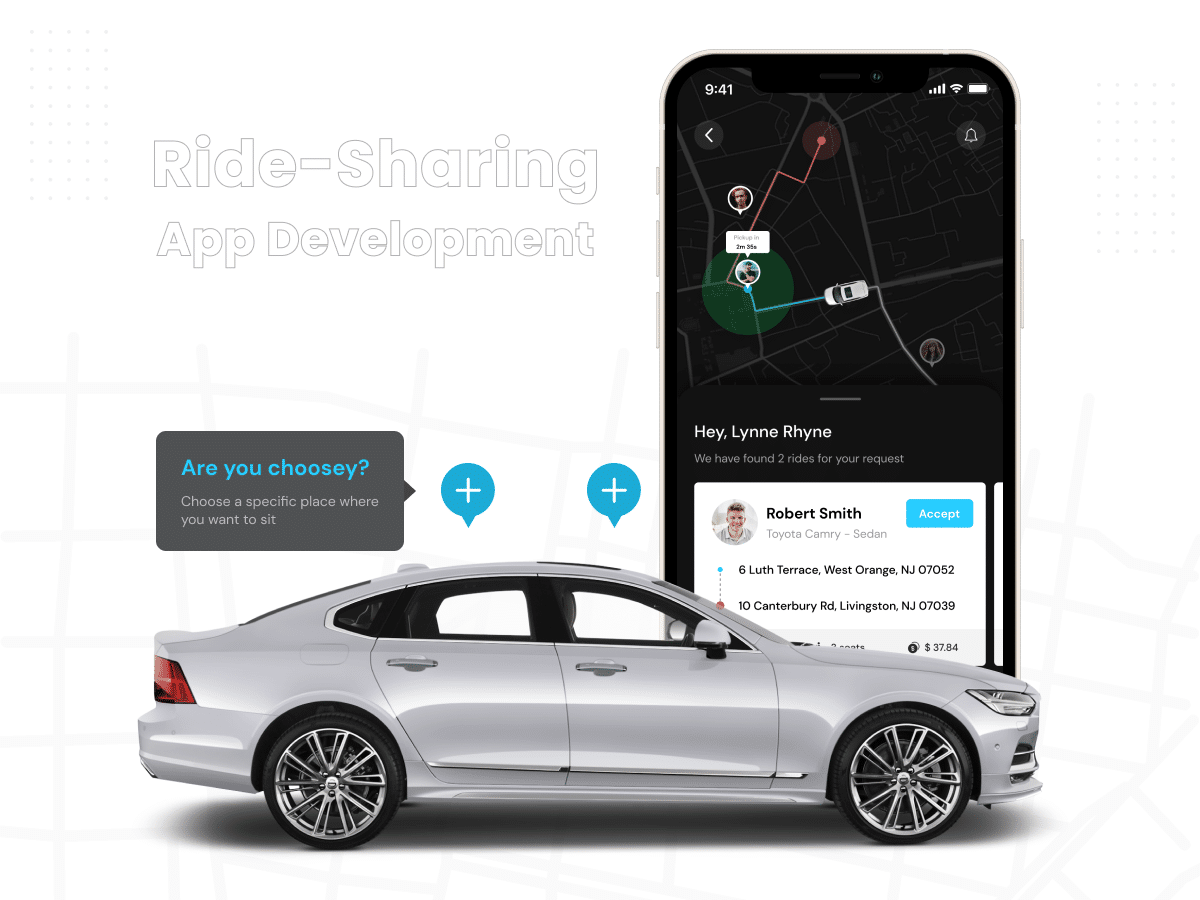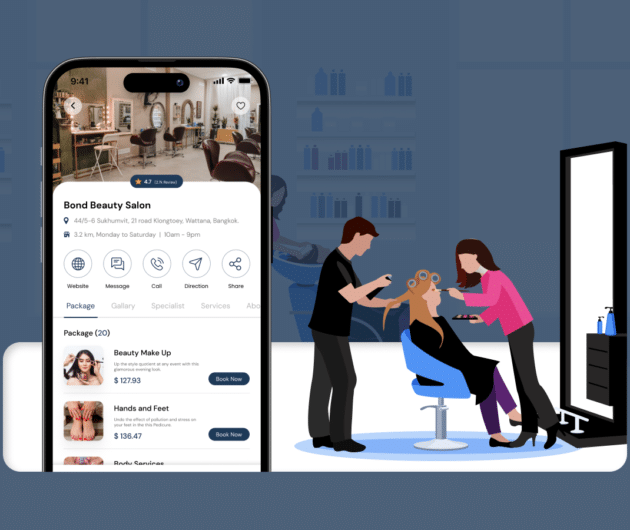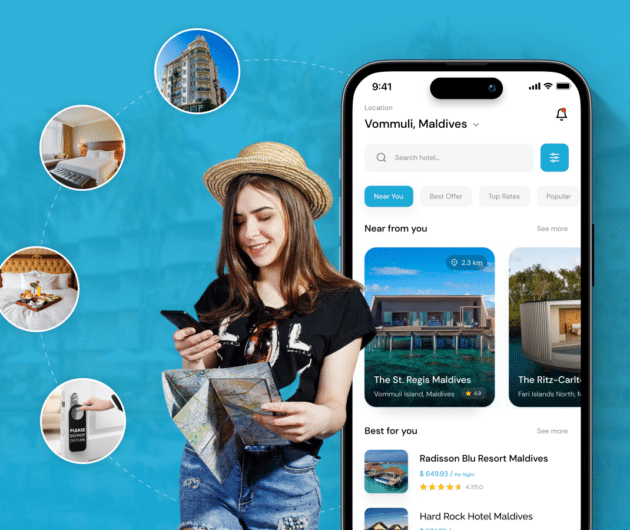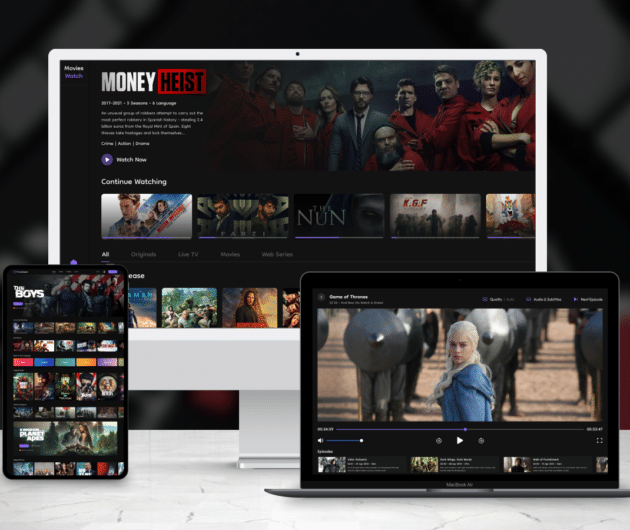How to Build a Ridesharing App? [Steps + Cost]

-
Ankit Patel
- December 21, 2023
- 6 min read
Ride-sharing apps have redefined the way people commute, seizing the reins from traditional transportation methods. This holds particularly true for transport companies that have identified ride-sharing as a gold mine for business growth.
The global ridesharing app market is a booming industry, projected to reach a staggering $215.70 billion by 2028.
As the market of ride-sharing is still experiencing tremendous growth, it’s a worthy investment to develop a ridesharing app like Uber or Lyft.
Creating a ride-sharing app for your business can be the missing puzzle piece that skyrockets your success and makes your transportation services more efficient, more accessible, and more popular among consumers. With an increasing preference for app-based ride booking, driven by companies like Uber and Lyft, building your own ride-sharing app isn’t just a luxury but an essential requirement for business prosperity.
So, whether you are already in the on-demand taxi business looking to augment your operations, or you are a startup keen to carve a niche in the burgeoning market of ride-sharing, this blog is just for you. Our expert developers, who’ve successfully crafted a ride-sharing app for our Japan-based client, have put together a complete, easy-to-follow guide just for you.
Key Highlights of the Ridesharing Market
- In 2023, the global ride-sharing market was valued at $154.00 billion, with a predicted increase to $215.70 billion by 2028.
- 26% of ridesharing app users opt for monthly taxi booking services out of 100.
- In the US, 36% of Americans actively use ridesharing applications.
- Uber holds a 71% market share and generated $31.8 billion in revenue throughout 2022.
- 70% of those who walk or ride a bike also use ride-sharing services.
Top 6 Ridesharing Applications
- Uber: USA-based ride-sharing app
- Lyft: San Francisco-based ride-sharing company
- DiDi: Chinese rideshare company
- BlaBlaCar: French ridesharing and carpooling company
- Grab: A Singapore-based ride-hailing company
- Curb: USA-based ride-sharing app

How Do Apps for Sharing Rides Work?
Ride-sharing apps are not like regular taxis. In these apps, more than one person can share the same ride. It’s like ordering a taxi that you share with others. It happens right when you need it.
These apps use real-time communication, which means everything, from seeing the map live to chatting and getting alerts, happens instantly. It makes the whole experience more interesting for users.
Now, let’s talk about how these apps work.
- First, a user who is looking for a ride has to sign up through the app.
- Then enter your pickup and drop-off locations. Then, the driver receives a notification about your request and decides whether to accept or reject it.
- If the driver accepts, you’ll see their car’s details, other passenger details, and estimated arrival time.
- Users can track the driver’s location on a map in real-time.
- The user pays for the ride based on how far they travel. Everyone in the ride shares the cost.
- After completion of the ride, users can rate the driver and leave feedback.
Also check: How To Develop a Ride Sharing App Like Grab?
Must-Have Features of Ridesharing Apps
There are several distinctive features needed for ridesharing app development to satisfy the challenging needs of current transportation. The features of a ridesharing app are categorized based on the specific app versions created for passengers and drivers, respectively.
| User App | Driver App | Admin Panel |
|---|---|---|
| Ride booking | Ride accept/reject | Ride monitoring |
| Real-time tracking | Real-time location sharing | Track route and drivers |
| Multiple payment options | Payout details | Manage payments |
| Push notifications | Push notifications | Announcement and alerts |
| Promotions/Discounts | Promotional incentives | Promotional campaigns |
| Manage profile | Manage profile | Manage users and drivers |
| Ride history | Earning history | Support ticket handling |
| Emergency assistance | Emergency response | Emergency alerts |
| Rating and Reviews | Rating and feedback | Rating management |
Also check: 11 Best Ridesharing Apps to Consider While Building a Taxi App
How to Develop a Ridesharing App?
Now that you know what features are required for both rider and driver, let’s talk about actually building the app. Here’s a simple list of steps to guide you through creating a ride-sharing app:
Step 1: Market Research
To kick off the carpooling app development, start with a comprehensive market analysis. Dive into the ridesharing landscape to gauge its potential and understand the competition. Look for gaps in current apps and gain insights into your competitors.
Here are some of the questions you should ask during this phase:
- What is my target audience?
- What are the problems that current apps can’t fix?
- How is my app bridging the gap between the current market and the users’ needs?
- What is my app’s USP?
Step 2: Value Proposition Analysis
Now, delve into the core of your app’s unique selling points. Engage in brainstorming sessions to unearth distinctive features that will set your ridesharing app apart in the market. Be strategic in selecting features that not only align with your overall concept but also resonate with your target audience, forming the foundation for a compelling value proposition.
Step 3: Development Approach
Next, carefully choose your ride-hailing app development approach. Decide between native, cross-platform, or hybrid app development based on your project requirements. If you opt for native development, specify the tools and languages for both Android and iOS. Alternatively, consider cross-platform frameworks like Flutter or React Native.
Here’s the list of technologies used for making a ride-sharing app:
- For Android – Kotlin, Java, Flutter, React Native
- For iOS – Swift, Flutter, React Native
- Frontend – React.js, HTML, CSS
- Backend – Node.js, Express.js, Python
- Payments – Braintree, PayPal, Stripe, eWallet
- Push notifications – Twilio, Push.io
- Database – MongoDB, MySQL, PostgreSQL
- Cloud Services – AWS, Google Cloud
- Real-Time Analytics – Hadoop, Spark, BigData
- Real-Time Location – Google Maps, Google Places API
Step 4: Create Your MVP (Minimum Viable Product)
Make a strategic decision between developing a full-fledged product or starting with a Minimum Viable Product (MVP). If resources are limited, the MVP route allows you to focus on essential features that define your app’s value proposition. Develop the MVP to serve as a preliminary version, incorporating the fundamental features necessary to showcase the app’s value proposition. This initial phase serves not only to test your concept with users but also to gather valuable feedback, which will guide subsequent improvements and refinements.
Step 5: Launching & Testing
With your MVP in hand, proceed to the crucial stages of testing and launching. Subject your app to meticulous testing by a quality assurance professional, ensuring any bugs or issues are identified and addressed. Once the necessary adjustments have been made, submit your app to the respective app stores for review. Be mindful of potential delays during the app store approval process.
Step 6: Obtain Consumer Feedback
Following the app’s launch, actively seek feedback from users to gain a comprehensive understanding of their experiences. Use this valuable input to make necessary changes and enhancements based on user recommendations. Embrace an iterative approach, continuously refining and expanding the functionality of your app to meet evolving user needs and expectations.
How Much Does It Cost to Develop a Ridesharing App?
Ever wondered about the ride-sharing app cost? Well, it varies based on what you are aiming for. If you are looking at a basic app with essential features, the cost might range from $15,000 to $25,000. However, should your aspirations lean towards a more intricate application, complete with advanced functionalities, the cost could soar to a bracket of $25,000 to $50,000 or more.
However, these are rough estimations because the overall budget depends on several factors such as app platforms (Android, iOS, or both), UI/UX design, features & functionalities, third-party API integrations, app complexity, and the location of the app development company you choose.
Therefore, it’s imperative to carefully evaluate your unique requirements against your budget constraints before embarking on the endeavor of creating your very own taxi app.

How Can XongoLab Assist You in Building a Ride-Sharing App?
We understand the unique needs and aspirations of businesses in the transportation industry. That’s why we offer cutting-edge clone app development solutions that can be fully customized to suit your specific requirements.
Our clone app solution is built on the tried and tested foundation of successful ride-sharing apps, providing a solid and reliable platform for your taxi business to thrive.
It is pre-built and ready to use, allowing you to launch your ride-sharing service quickly. The app is designed to be easily customizable, allowing you to tailor it to fit your brand’s unique identity. This saves you valuable time and money that would otherwise be spent on the lengthy development process. With our app, you can enter the market promptly and start providing services to users without delays.
Summing up
As the market of ride-sharing is still experiencing tremendous growth, with room for innovations and unique solutions, it’s a worthy investment to develop a ride-sharing app like Uber or Lyft. However, such an endeavor also comes with its set of challenges such as stringent regulatory norms, intense competition, and high development costs. Overcoming these requires an in-depth understanding of the market and careful planning. Therefore, a thorough approach is required to develop an effective, efficient, and successful ridesharing app. For this reason, it is essential to find the right taxi app development company so that your app development process doesn’t get stuck at any stage. We at XongoLab ensure that you get the maximum benefit for your investment. So, don’t delay and revolutionize your transportation vision with XongoLab, the architect of cutting-edge ride-sharing apps.
You may also like

How to Choose the Right Mobile App Development Company
-
Ankit Patel
Imagine this: you’ve got a brilliant app idea that could revolutionize your business, take it to new heights, and transform your entire customer experience. But without the right team to… Read More

How Much Does it Cost to Build a Salon Booking App like Fresha?
-
Ankit Patel
We all have witnessed the buzz in the world of beauty & wellness, and it’s booming every day thanks to the fast-paced and stressful lifestyle. In an era where time… Read More

A Complete Guide to Hotel Booking App Development With Cost
-
Ankit Patel
Whether it’s a corporate business trip or a relaxing vacation with friends, finding the right hotel at the right time and a seamless hotel booking experience is not a luxury… Read More





